You Get What You Tolerate… 3 Business (and Life) Changes You Need To Make Now! (video)
In this short-and-powerful video, I’m sharing some of the most profound words anyone ever said to me. They came from my father-in-law, and although I’m using them in the context of you building your coaching business, they actually apply to every facet of your life: business, relationships, family, friendships, everything! Watch the video now to hear these words of wisdom—which will at once liberate you and make you realize how YOU are responsible for how your life feels now.
 Once you liberate yourself—and take responsibility for creating exactly the life and business you want—then you’ll definitely want to download this complimentary resource designed to help you leverage your time, money, energy, and resources to run your business like a well-oiled machine. It’s The Coaching Business Roadmap to Success: The Precise Sequence to Set up and Launch Your Coaching Business—Fast! Go here to grab it:
Once you liberate yourself—and take responsibility for creating exactly the life and business you want—then you’ll definitely want to download this complimentary resource designed to help you leverage your time, money, energy, and resources to run your business like a well-oiled machine. It’s The Coaching Business Roadmap to Success: The Precise Sequence to Set up and Launch Your Coaching Business—Fast! Go here to grab it:
>> Discover The Behind-The-Scenes Magic That Makes Your Biz Run Smoothly.
Transcript:
Hello there!
Today I want to share with you some profound words that my father-in-law shared with me when I first met him. Something he said all of his life, and when he did, he kind of shook my world, changed my world, and it’s still true some 12 years later. And I used this in my business, in my life, in my relationships, with my family, with absolutely everything. And the words he said to me: “You get what you tolerate.”
At the same time he shared that with me I was like: “wow, that is liberating, right?” Maybe you’ve heard me talk about this. This is so important, right? You get what you tolerate. Not only is it important, but it’s also freeing and it kind of sucks! Because now you have to take responsibility for what’s in front of you. I want to share three quick things with you today that you must stop tolerating. Not only in your business, but most likely also in your life.
The first one is: doing everything manually. A lot of entrepreneurs have this belief when they’re first getting started; that they’ll just kind of do it on their own, do it manually. They reinvent the wheel every time with every prospect and every client. And the only thing that has you doing it’s working harder, working longer hours and getting way stressed out. You can leverage people, tools and resources to create automation, integration and streamline your business. So be careful what you’re tolerating when you’re doing everything manually and reinventing that wheel.
The second thing that you’re tolerating: limiting beliefs. Now this one’s tricky! You’ve got to get connected to a community, because they’re gonna reflect back to you pretty quickly when you’re buying into limiting beliefs. A lot of times you don’t even realize that you’re doing it, you don’t know that you’re doing it, so having that community reflected back to you, you can call it out quickly, stop tolerating, change those beliefs, set you off on a free path in your business and your life.
And then the final one is – how do I say this? Well, I can’t say this nicely… You’re putting everybody else as a priority in front of you. Especially as women; especially as mom entrepreneurs. It’s also true for the guys. But one of the things that we tolerate is we think we have to take care of everyone and everybody else and everything else. And then we come last, and our business comes last. The more that you give of your business, the more it can take care of your family. The more you prioritize yourself, the more you have to give to your family, your business, your friends, your colleagues. So stop tolerating that you’re on the bottom of the list! Get yourself on the top of the list. Give of the overflow, and everything works better, smoothly and it’s way more fun.
So remember those words – I’m gonna be sitting on your shoulder – you get what you tolerate. It’s freeing, kind of sucks, but ultimately, it’s liberating. It’ll be a secret to your success.

